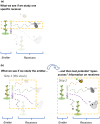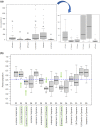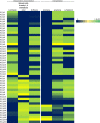A new conceptual and quantitative approach to exploring and defining potential open-access olfactory information
- PMID: 35975694
- PMCID: PMC9826502
- DOI: 10.1111/nph.18432
A new conceptual and quantitative approach to exploring and defining potential open-access olfactory information
Abstract
All organisms emit odour, providing 'open-access' olfactory information for any receiver with the right sensory apparatus. Characterizing open-access information emitted by groups of organisms, such as plant species, provides the means to answer significant questions about ecological interactions and their evolution. We present a new conceptual framework defining information reliability and a practical method to characterize and recover information from amongst olfactory noise. We quantified odour emissions from two tree species, one focal group and one outgroup, to demonstrate our approach using two new R statistical functions. We explore the consequences of relaxing or tightening criteria defining information and, from thousands of odour combinations, we identify and quantify those few likely to be informative. Our method uses core general principles characterizing information while incorporating knowledge of how receivers detect and discriminate odours. We can now map information in consistency-precision reliability space, explore the concept of information, and test information-noise boundaries, and between cues and signals.
Keywords: cue; ecological interactions; information recovery; signal; volatile organic compounds.
© 2022 The Authors. New Phytologist © 2022 New Phytologist Foundation.
Figures







Similar articles
-
Olfactory misinformation provides refuge to palatable plants from mammalian browsing.Nat Ecol Evol. 2024 Apr;8(4):645-650. doi: 10.1038/s41559-024-02330-x. Epub 2024 Feb 2. Nat Ecol Evol. 2024. PMID: 38307993 Free PMC article.
-
Framework for the use of odour wheels to manage odours throughout wastewater biosolids processing.Sci Total Environ. 2018 Sep 1;634:214-223. doi: 10.1016/j.scitotenv.2018.03.352. Epub 2018 Apr 5. Sci Total Environ. 2018. PMID: 29627544
-
Exploring natural odour landscapes: A case study with implications for human-biting insects.bioRxiv [Preprint]. 2023 May 30:2023.05.08.539789. doi: 10.1101/2023.05.08.539789. bioRxiv. 2023. PMID: 37398328 Free PMC article. Preprint.
-
Plant odour plumes as mediators of plant-insect interactions.Biol Rev Camb Philos Soc. 2014 Feb;89(1):68-81. doi: 10.1111/brv.12043. Epub 2013 May 28. Biol Rev Camb Philos Soc. 2014. PMID: 23714000 Review.
-
Do Plants Eavesdrop on Floral Scent Signals?Trends Plant Sci. 2016 Jan;21(1):9-15. doi: 10.1016/j.tplants.2015.09.001. Epub 2015 Oct 17. Trends Plant Sci. 2016. PMID: 26476624 Review.
Cited by
-
Olfactory misinformation provides refuge to palatable plants from mammalian browsing.Nat Ecol Evol. 2024 Apr;8(4):645-650. doi: 10.1038/s41559-024-02330-x. Epub 2024 Feb 2. Nat Ecol Evol. 2024. PMID: 38307993 Free PMC article.
References
-
- Ache BW, Young JM. 2005. Olfaction: diverse species, conserved principles. Neuron 48: 417–430. - PubMed
-
- Aljbory Z, Chen MS. 2018. Indirect plant defense against insect herbivores: a review. Insect Science 25: 2–23. - PubMed
-
- Auffarth B. 2013. Understanding smell – the olfactory stimulus problem. Neuroscience & Biobehavioral Reviews 37: 1667–1679. - PubMed
Publication types
MeSH terms
LinkOut - more resources
Full Text Sources

